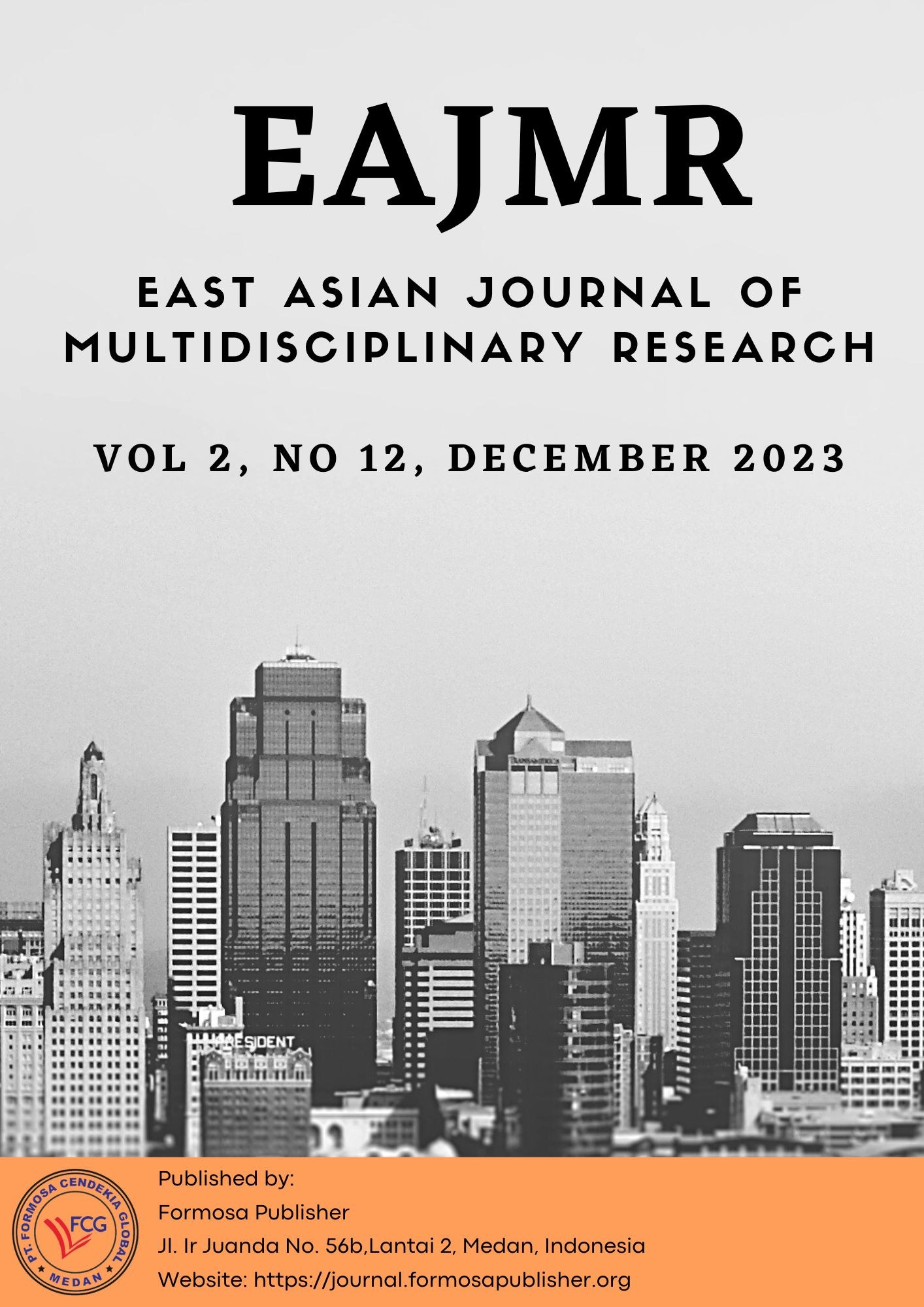Business Feasibility of Pagoda Mustard (Brassica Narinosa) with Hydroponic Wick System Model
DOI:
https://doi.org/10.55927/eajmr.v2i12.7312Keywords:
Feasibility, Hydroponic Wick System, Pagoda MustardAbstract
The potential and business opportunities of pagoda mustard commodities can be said to be very open, but technical and financial information about production is still very limited. Pagoda mustard greens are one type of mustard greens that contain many nutrients and antioxidants that function as cancer preventers. The purpose of this research is to provide an overview of the business of pagoda mustard commodities, especially with the hydroponic wick system cultivation system. The research method used in this study is the calculation of production costs, revenue, income, and feasibility. The research was conducted in a green house in Tamansari District, Tasikmalaya. The results showed that with the green house land area used was 40 m2, the production cost was IDR 2,127,986 with total revenue generated of IDR 4,928.95, so that the total income earned was IDR 2,800,000. The feasibility level obtained in pagoda mustard cultivation with hydroponic wick system is 2.31, indicating that it is feasible.
References
Ardana, K.B., Pramudya, M.H. and Tambunan, A.H. (2008). Jatropha curcas (L) development to support energy independent area in Nusa Penida, Bali. Littri Journal 14(4): 155-161.
Blank, L. and Anthony, T. (2002). Engineering Economy, 5th ed. Mc.Graw Hill, New York.
Boediono. (1999). Synopsis Series of Introduction to Economics No. 4: Theory of Economic Growth. Yogyakarta: BPFE Yogyakarta.
Cahyono, B. (2003). Techniques and Strategies for Cultivating Green Mustard (Pai-Tsai). Pustaka Nusatama. Yogyakarta.
De Garmo, E.E., Paul, W.G., Sullivan and Canada, J.R. (1984). Engineering Economics, 7thed. Mac MillanPub.Co, New York.
Decision Making. Yogyakarta: BPEFE -Yogyakarta.
Diatin, I., Sobari, M.P. and Irianni, R. (2007). Financial feasibility analysis of wanayasa tilapia farming in mekarsari farmer group. Indonesian Aquaculture Journal 6(1): 97-102.
Erlina (2006). Analysis of rubber-based agroindustry design. Journal of Business and Management 3(1): 73-92.
Fazwa, M.A.F., Fauzi, P.A., Ab, A.G., Rasip and Noor, M.M. (2001). A preliminary analysis on financial assessment of Citrushystrix (limau purut) grown on plantation basis, Forest Research Institute Malaysia (FRIM), 52109 Kepong, Selangor Darul Ehsan, Project No. 01- 04-01-0094-EA001.
Firmansyah, B.A., Veronika, A. and Trigunarsyah, B. (2006). Risk Analysis in feasibility study of building construction project: Case study-PT. Perusahaan Gas Negara Indonesia. The Tenth East Asia-Pacific Conference on Structural Engineering and Construction, Bangkok, Thailand, 2006. Bangkok August 3-5, Thailand.
Haryanto, E., T. Suhartini, E. Rahayu, and Sunarjo. (2006). Mustard and Lettuce. Penebar Swadaya. Jakarta.
Herwibowo, K., & Budiana, S. N. (2014). "Vegetable Hydroponics for Hobby and Business". East Jakarta: Penebar Swadaya.
Idham, A., Lestari, T. and Adriani, D. (2010). Financial analysis of cattle-based integrated farming system in oganilir district. Journal of Human Development 6. http://balitbangdasumsel.net/ data/download/ 20100414125413.pdf. [April 3, 2011].
Istiqomah, S. (2006). "Growing Hydroponics". Jakarta: Azka Press.
Kusuma, P.T.W.W., Arbita, K.D., Putri, S.A. and Maryani, N.F. (2010). Financial analysis of the development of small and medium enterprises (SMEs) producing sweet potato flakes (emergency food) (case study of UKM mandiri pangan mapan makmur, Gunung Kidul). Seminar on Application and Research in Industrial Technology 2010 (SMART): C1-C6. Yogyakarta, July 29, 2010: Gadjah Mada University Yogyakarta.
Kusuma, P.T.W.W., Hidayat, D.D. and Indrianti, N. (2012). Financial feasibility analysis of nata de coco small and medium enterprise (SME) development in Sumedang, West Java. Jurnal Teknotan 6: 670-676.
Kusumanto, I. (2008). Net present value (NPV) inter nal and rate of return (IRR). http://kuliahft. umm.ac.id/ pluginfile.php/171/ mod_folder/ content/1/ Economic%20Teknik/5.%20NPV%20IRR. ppt?forcedownload=1. [August 28, 2013].
Larkcom J. (2007). Oriental vegetables. Frances Lincoln Ltd, London, UK. 232 pp.
National Association of Certified Valuation Analysts (2005). Analysis of the Statement of Cash Flow and Financial Ratio Analysis, Fundamentals, Techniques and Theory 1995-2005. NACVA, Utah.
Nugraha, R. U. (2015). Source as a nutrient substitute for AB Mix in hydroponic leaf vegetable cultivation. J. Hort Indonesia. Bogor. 6(1):11-19.
Pujawan, I.N. (2004). Engineering Economics. Publisher Guna Widya, Surabaya.
Rantala, J., Harstela, V.M., Saarinen and Tervo, L. (2009). A Techno-Economic Evaluation of Bracke and M-Planter Tree Planting Devices. Research Article of the Finnish Society of Forest Science ISSN 0037-5330. The Finnish Forest Research Institute Silva Fennica: p 43(4).
Rukmana. (2002). Growing Petsai and Mustard. Kanisius, Yogyakarta.
Said, A. (2007). "Hydroponic Cultivation of Cucumber and Annuals". Jakarta: Azka Press.
Setyoadji D. (2015). Hydroponic Plants. Araska 2015, Yogyakarta.
Simanullang, Arjuna Yohannes, Ni Luh Kartini, & Anak Agung Istri Kesumadewi. (2019). Effect of Organic and Inorganic Fertilizers on the Growth and Yield of Green Mustard Plants (Brassica rapa L.). AGROTOP. 9 (2).
Soehardi, Sigit. (1993). Break Even Analysis. BPFE. Yogyakarta.
Soeharsono, S. (1989). Building Human Works. Sinar Harapan Library. Jakarta.
Soekartawi. (2006). Agribusiness Theory and Application, Raja Grafindo Persada. Jakarta.
Sudarman Ari. 2004. Microeconomic Theory. 4th Edition, BPFE UGM, Yogyakarta.
Sugiarto. (2002). Production Management (Production Control), Pt Gramedia Pustaka Utama. Jakarta.
Supriyono. (2000). Cost Accounting - Planning and Controlling Costs as well as
Surahman, D.N., Astro, H.M. and Priyatna, H. (2008). Business Plan: Agroindustry Business Review, Case Study of Pineapple Small and Medium Enterprises. LIPI Press, Jakarta.
Suratiyah, Ken. (2015).Farming Science (Revised Edition). Penebar Swadaya. Jakarta.
Sutojo, S. (2000). Project Feasibility Study, Theory and Practice.Gramedia, Jakarta.
Yulia, A.E., Murniati, Fatimah. (2011). Application of Organic Fertilizer on Caisim Plants for Two Planting Times. Riau. 10(1):14-19.
Zatnika, I. (2010). Techniques and Strategies for Cultivating Green Mustard. Jakarta. Media Indonesia. Growth of mustard vegetables. Bioshell, 6(1).
Downloads
Published
How to Cite
Issue
Section
License
Copyright (c) 2023 Nurul Risti Mutiarasaru, Yogi Nirwanto

This work is licensed under a Creative Commons Attribution 4.0 International License.







.png)





















